Sustainable seafood practices offer health benefits while protecting marine ecosystems. This article explores responsible fishing methods, highlights local cuisines that promote sustainability, and details the nutritional advantages of consuming sustainably sourced seafood. Understanding these principles empowers consumers to make informed choices that support both their health and the environment.

What are the principles of sustainable seafood practices?
Sustainable seafood practices prioritize responsible fishing methods, local sourcing, and health benefits. These principles ensure the protection of marine ecosystems while providing nutritious food options.
Responsible fishing practices include methods that minimize bycatch and habitat destruction. Local cuisines often emphasize seasonal and sustainably sourced seafood, which supports local economies and reduces carbon footprints. Health benefits of sustainably sourced seafood include high levels of omega-3 fatty acids, which promote heart health.
Implementing these principles leads to a more sustainable seafood industry, ensuring future generations can enjoy marine resources.
How does overfishing impact marine ecosystems?
Overfishing severely disrupts marine ecosystems by depleting fish populations and altering food webs. This loss of biodiversity can lead to the collapse of certain species and negatively impact local fishing communities. As a result, sustainable fishing practices are essential for maintaining ecological balance and supporting seafood sustainability. Overfishing also affects the health of ocean habitats, such as coral reefs and seagrass beds, which are vital for numerous marine species. Implementing responsible fishing practices can help restore these ecosystems and ensure long-term seafood availability.
Why is responsible fishing important for future generations?
Responsible fishing is crucial for ensuring seafood sustainability and protecting marine ecosystems for future generations. It promotes the health of fish populations, supports local economies, and preserves biodiversity. Sustainable practices help maintain fish stocks at healthy levels, allowing communities to rely on fishing as a food source and livelihood. Overfishing threatens not only current supplies but also the ability of future generations to enjoy seafood. By adopting responsible methods, we can ensure that fisheries remain productive and ecosystems thrive, fostering a balanced relationship between humans and nature.

Which fishing methods are considered environmentally friendly?
Environmentally friendly fishing methods include sustainable practices like selective fishing, trap fishing, and aquaculture. These methods minimize bycatch and habitat damage, promoting seafood sustainability. For example, trap fishing reduces the impact on marine ecosystems by targeting specific species. Aquaculture, when managed properly, offers a renewable source of seafood, decreasing pressure on wild populations. Sustainable practices support local economies and preserve marine biodiversity, ensuring healthier oceans for future generations.
What role do aquaculture systems play in sustainability?
Aquaculture systems play a crucial role in promoting seafood sustainability by reducing overfishing and supporting local economies. These systems provide a controlled environment for fish farming, ensuring a steady supply of seafood while minimizing environmental impact. For instance, well-managed aquaculture can lower carbon emissions compared to traditional fishing methods.
Moreover, aquaculture supports biodiversity by allowing wild fish populations to recover. It can also enhance food security by providing affordable protein sources for local communities. Sustainable practices in aquaculture, such as using feed from sustainable sources and implementing eco-friendly farming techniques, further contribute to environmental preservation.
As a result, aquaculture systems are integral to achieving a sustainable seafood supply chain, benefiting both consumers and the planet.
How can bycatch reduction techniques improve fishing practices?
Bycatch reduction techniques enhance fishing practices by minimizing waste and promoting sustainability. These methods, such as using selective gear and implementing seasonal closures, reduce unintended catch of non-target species. As a result, fish populations remain stable, supporting local ecosystems and economies. Sustainable practices also align with consumer preferences for responsible seafood, fostering healthier local cuisines.
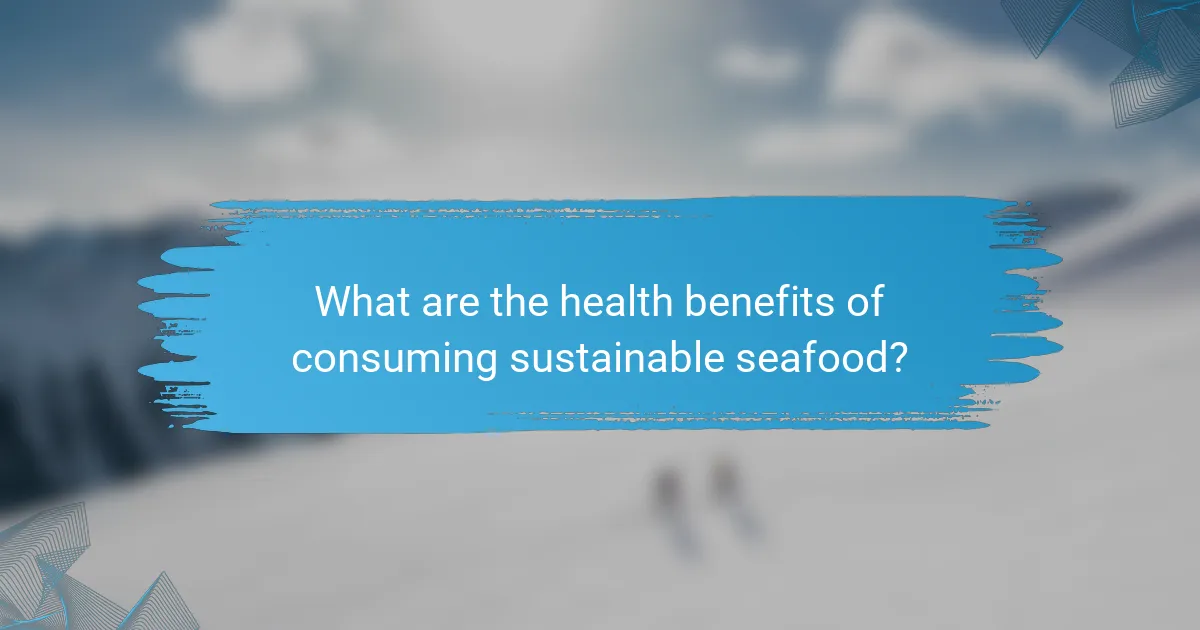
What are the health benefits of consuming sustainable seafood?
Consuming sustainable seafood offers numerous health benefits. It provides essential nutrients like omega-3 fatty acids, which support heart health and brain function. Sustainable seafood is often fresher, leading to better taste and higher nutritional value. It also promotes healthier ecosystems, ensuring that fish populations remain robust. By choosing sustainable options, consumers contribute to responsible fishing practices that protect marine habitats. This choice can lead to improved overall health and well-being.
How does seafood contribute to a balanced diet?
Seafood plays a crucial role in a balanced diet by providing essential nutrients, promoting sustainable practices, and enhancing local cuisines. It is a rich source of high-quality protein, omega-3 fatty acids, vitamins, and minerals. These nutrients contribute to heart health, brain function, and overall well-being.
Sustainable seafood practices ensure that fishing methods do not deplete fish populations or harm ecosystems. Choosing locally sourced seafood supports community economies and reduces carbon footprints. For instance, consuming seasonal fish varieties can lead to fresher meals and support responsible fishing practices.
Incorporating seafood into meals can also diversify diets, offering unique flavors and culinary experiences. The health benefits of seafood, such as lowering cholesterol and reducing inflammation, make it a valuable addition to any balanced diet.
What nutrients are abundant in various seafood types?
Seafood types are rich in nutrients like omega-3 fatty acids, proteins, vitamins, and minerals. For instance, salmon is abundant in omega-3s and vitamin D, while shellfish like oysters provide zinc and vitamin B12. These nutrients contribute to heart health, immune function, and overall wellness. Sustainable seafood practices ensure these nutritional benefits are available for future generations, linking health benefits to responsible fishing methods.
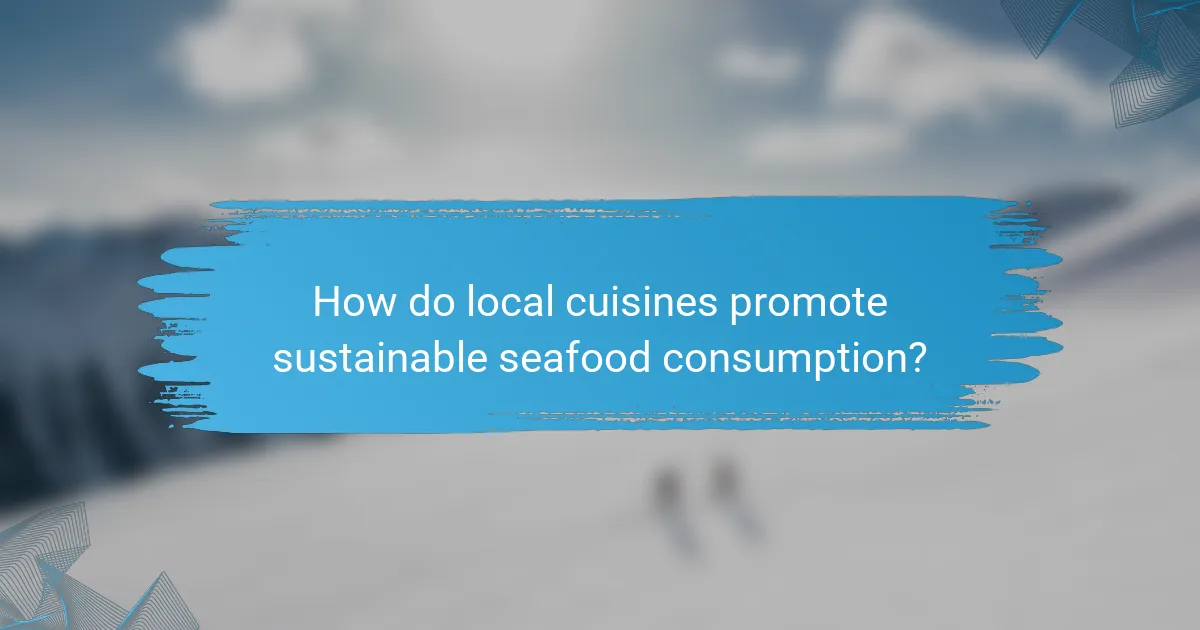
How do local cuisines promote sustainable seafood consumption?
Local cuisines promote sustainable seafood consumption by emphasizing local sourcing and traditional practices. These cuisines often highlight seasonal fish, reducing overfishing and supporting local economies. For instance, communities that prioritize indigenous recipes encourage the use of lesser-known species, which helps maintain biodiversity. Additionally, local seafood markets foster transparency in fishing methods, allowing consumers to make informed choices. This approach not only enhances the health benefits of seafood but also strengthens community ties and environmental stewardship.
Which regional dishes highlight sustainable seafood practices?
Sustainable seafood practices are highlighted in regional dishes like ceviche from Peru, poke from Hawaii, and bouillabaisse from France. These dishes often feature fish sourced from responsible fisheries that prioritize ecological balance and community support. For example, ceviche uses local, sustainably caught fish, promoting both health benefits and environmental stewardship. Additionally, many regions emphasize seasonal seafood, reducing overfishing and ensuring fish populations remain stable.
What is the impact of local fishing traditions on sustainability?
Local fishing traditions significantly enhance sustainability by promoting responsible practices and preserving marine ecosystems. These traditions often prioritize community involvement and respect for seasonal changes. For example, many local fishermen use selective gear and limit catch sizes to prevent overfishing. This approach not only supports fish populations but also ensures the availability of seafood for future generations. Furthermore, traditional knowledge contributes to biodiversity conservation, as locals understand the importance of maintaining healthy habitats. Overall, integrating local fishing customs into broader sustainability efforts can lead to healthier oceans and more resilient coastal communities.
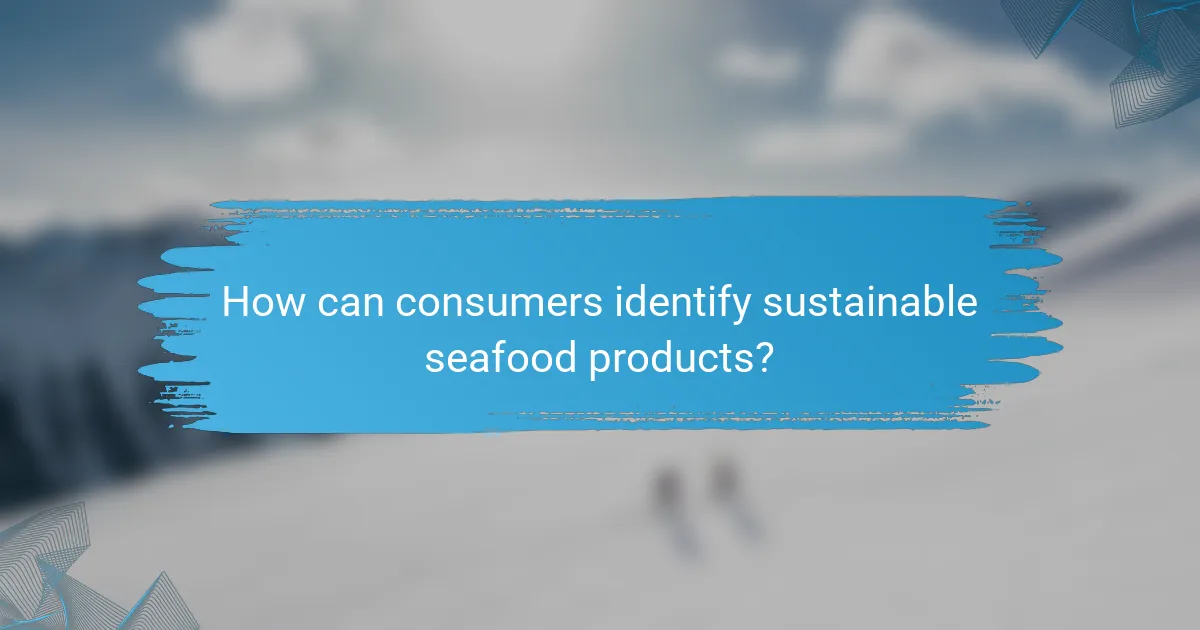
How can consumers identify sustainable seafood products?
Consumers can identify sustainable seafood products by looking for certifications, understanding local fishing practices, and knowing the species’ health benefits. Certifications like the Marine Stewardship Council (MSC) or Aquaculture Stewardship Council (ASC) indicate responsible sourcing. Local cuisines often highlight sustainable options, reflecting regional fishing practices. Additionally, consumers should be aware of the health benefits associated with specific seafood species, such as omega-3 fatty acids in salmon. This knowledge empowers consumers to make informed choices that support sustainability.
What certifications should consumers look for?
Consumers should look for certifications like Marine Stewardship Council (MSC), Aquaculture Stewardship Council (ASC), and Friend of the Sea. These certifications ensure seafood is sourced sustainably and responsibly. The MSC label indicates wild-caught fish from sustainable fisheries, while ASC focuses on responsible aquaculture practices. Friend of the Sea certifies products from sustainable fishing and farming methods. Checking for these certifications helps consumers make informed choices that support marine conservation and local economies.
How can seafood labeling influence purchasing decisions?
Seafood labeling significantly influences purchasing decisions by informing consumers about sustainability practices. Clear labels enhance trust and promote responsible fishing, impacting choices toward eco-friendly options. For instance, certifications like the Marine Stewardship Council indicate sustainable sourcing, appealing to environmentally conscious buyers. As a result, consumers increasingly prioritize health benefits and local cuisines linked to sustainably sourced seafood, leading to more informed purchasing habits.
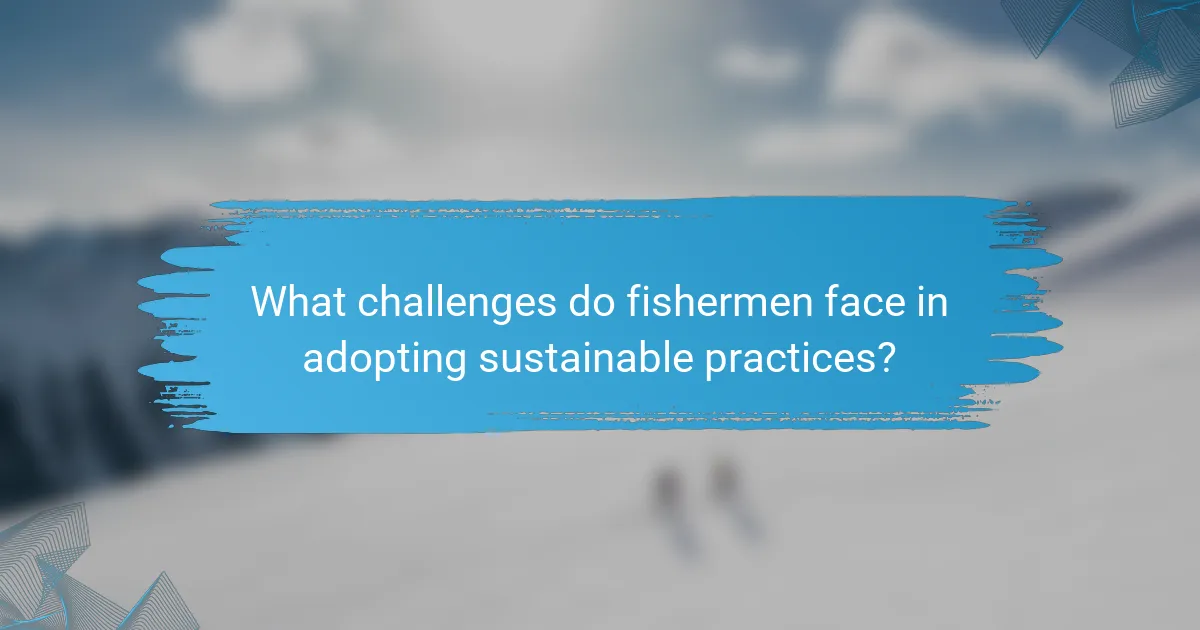
What challenges do fishermen face in adopting sustainable practices?
Fishermen face significant challenges in adopting sustainable practices, including economic pressures and regulatory complexities. Many fishermen rely on traditional methods that may not align with sustainability goals, risking overfishing. Additionally, market demand for cheaper seafood often undermines sustainable options. Training and access to resources for sustainable practices can be limited, further complicating the transition. As a result, balancing profitability with environmental responsibility remains a key obstacle in the fishing industry.
How do economic factors affect sustainable fishing efforts?
Economic factors significantly impact sustainable fishing efforts by influencing demand, pricing, and resource allocation. For instance, rising consumer awareness of sustainability can drive higher prices for responsibly sourced seafood. Conversely, economic downturns may lead to increased overfishing as companies prioritize profitability over sustainability.
Additionally, government subsidies can either support sustainable practices or encourage harmful fishing methods, depending on their design. Effective policies that promote responsible fishing can enhance local economies while preserving marine ecosystems. Ultimately, a balance between economic viability and environmental stewardship is crucial for sustainable fishing practices.
What role does government policy play in promoting sustainability?
Government policy significantly promotes sustainability in seafood by establishing regulations that encourage responsible fishing practices. These policies can include quotas, protected marine areas, and incentives for sustainable practices. As a result, they help maintain fish populations and protect marine ecosystems. Additionally, government support for local cuisines that prioritize sustainable seafood can increase public awareness and demand for responsible sourcing. This can lead to healthier diets and bolster local economies.
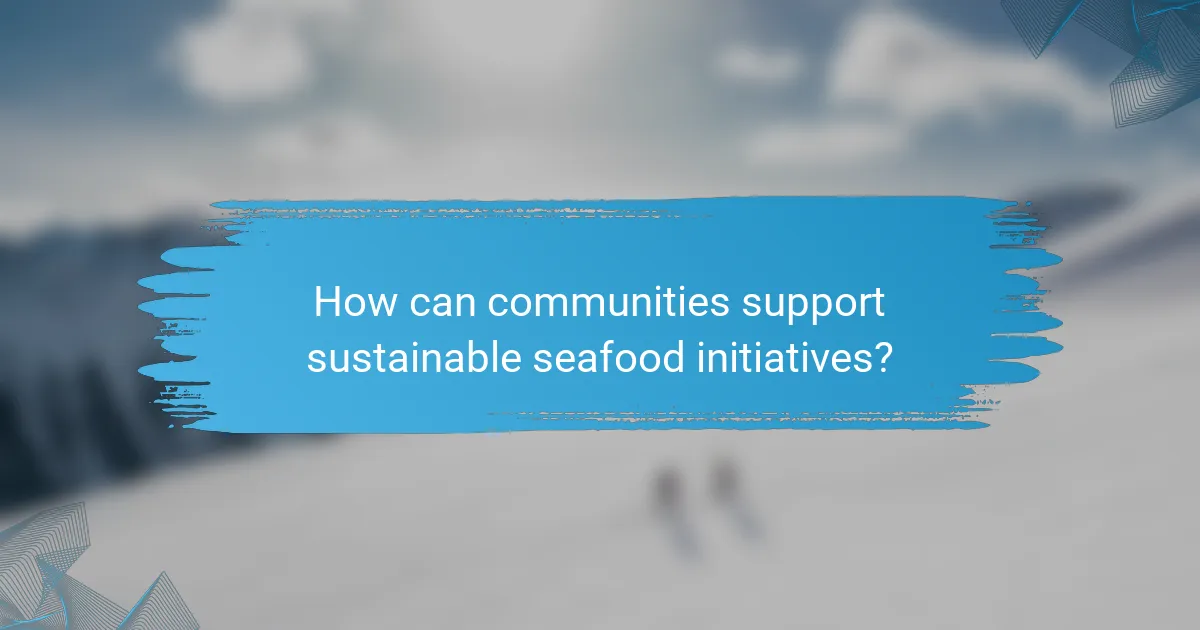
How can communities support sustainable seafood initiatives?
Communities can support sustainable seafood initiatives by promoting responsible fishing practices and local cuisines. Engaging local fishermen in sustainable practices reduces overfishing and protects marine ecosystems. Educational programs can raise awareness about the health benefits of consuming sustainably sourced seafood, such as improved nutrition and reduced environmental impact. Collaborations with local restaurants to feature sustainable seafood dishes can further encourage community support. Additionally, organizing community events focused on sustainable seafood can foster a culture of responsibility and environmental stewardship.
What are effective strategies for community engagement?
Effective strategies for community engagement include promoting local seafood initiatives, educating consumers about sustainable fishing, and hosting community events. These practices foster awareness and encourage participation in responsible seafood consumption. Collaborating with local chefs can highlight the health benefits of sustainable seafood, such as omega-3 fatty acids. Engaging local fishermen ensures authentic representation of fishing practices, enhancing community trust and support.
How can local markets help promote sustainable seafood?
Local markets promote sustainable seafood by connecting consumers with local fishermen who practice responsible fishing. This supports the local economy and encourages the consumption of seasonal, fresh seafood. Additionally, local markets often educate consumers about the health benefits of sustainably sourced seafood, such as higher omega-3 fatty acids and lower environmental impact. By fostering direct relationships between producers and consumers, local markets enhance awareness and commitment to sustainable practices.
What best practices should consumers follow when purchasing seafood?
Consumers should prioritize seafood that is sustainably sourced and locally caught. This ensures responsible fishing practices that protect marine ecosystems and support local economies. Look for certifications like the Marine Stewardship Council (MSC) or the Aquaculture Stewardship Council (ASC) to identify sustainable options. Additionally, consider the health benefits of seafood, such as high omega-3 fatty acid content, which supports heart health. Avoid overfished species to promote biodiversity and ensure future seafood availability.